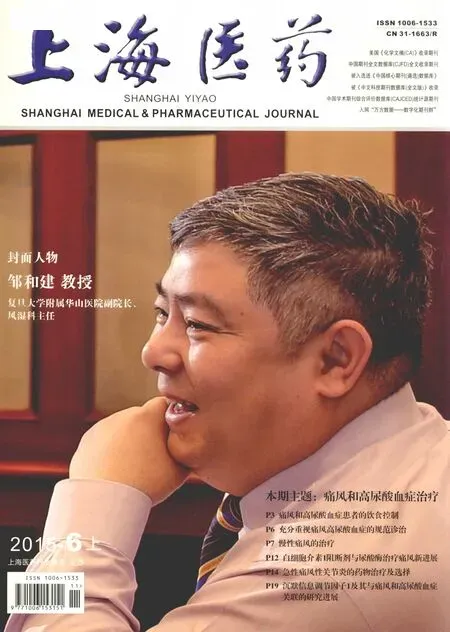痛風和高尿酸血癥患者的飲食控制*
宣丹旦薛愉 鄒和建*(復旦大學附屬華山醫院風濕科 上海 200040)
痛風和高尿酸血癥患者的飲食控制*
宣丹旦**薛愉 鄒和建***
(復旦大學附屬華山醫院風濕科 上海 200040)
隨著生活水平提高,痛風和高尿酸血癥的患病率也日益升高。飲食與痛風和高尿酸血癥的關系密切,是痛風和高尿酸血癥患者管理必不可少的部分。本文介紹痛風和高尿酸血癥患者的飲食控制。
痛風 高尿酸血癥 飲食
痛風為尿酸鹽沉積性炎性疾病,其發病的根本原因是高尿酸血癥。尿酸是嘌呤代謝的最終產物,故既往認為高嘌呤食物的攝入與高尿酸血癥及痛風密切相關。但新近的一些研究發現,并不只有高嘌呤食物會引起痛風。那么,究竟哪些食物屬于高嘌呤食物?高嘌呤食物都會引起痛風嗎?除了高嘌呤食物之外,還有哪些食物是痛風及高尿酸血癥患者需要避免食用的呢?又有哪些食物適合痛風患者食用呢?本文將回答這些問題。
1 應避免食用的食物
1.1 高嘌呤食物
常見的高嘌呤食物有海鮮、肉湯、動物內臟和大豆等。Choi等[1]對47 150名無痛風史的40歲以上男性隨訪12年,發現新發痛風病例730例,發病年齡的高峰在55 ~ 69歲間。研究發現,攝入大量的肉和海鮮會使血尿酸水平升高:攝入肉量最多組與最少組相比,相對危險度(relative risk, RR)為1.41(95% CI: 1.07 ~ 1.86);攝入海鮮量最多組與最少組相比,RR為1.51(95% CI: 1.17 ~ 1.95)。
高嘌呤食物的攝入不僅與血尿酸水平升高相關,而且研究證實還與反復的痛風發作相關。有研究對633例患者進行回顧分析,統計、分析痛風發作與嘌呤攝入量間的關系,發現嘌呤攝入量最高組與最低組相比,比值比(odds ratio, OR)為4.76[2]。
作為高嘌呤食物的代表,豆制品既往也在痛風患者的禁食名單中。但一項日本的研究表明,豆腐對血尿酸水平的影響并不大[3],認為可能是大豆中所含的嘌呤大部分在加工過程中被除去了。最新研究顯示,豆制品的攝入總量與高尿酸血癥的患病率間呈負相關關系[4-5],原因可能是豆類富含的嘌呤雖可導致血尿酸水平升高,但其也含有促尿酸排泄物質,且后者的作用更顯著。
那么,含高嘌呤的大豆會不會引起痛風呢?一項對2 076人進行的回顧性研究發現,含高嘌呤蔬菜的攝入與血尿酸水平升高的關系不大[6]。Choi等[1]的前瞻性研究也證實,高嘌呤食物(如大豆)與痛風的關系不大。目前尚無足夠的證據證實大豆或豆制品與痛風發病相關[5]。但為什么含高嘌呤的肉或海鮮會誘發痛風發生呢?現在研究認為,這主要與動物肉中含有游離脂肪酸有關。體外試驗顯示,游離脂肪酸可與尿酸鹽晶體組織相互作用而產生白介素-1β,最終導致痛風性關節炎的發生[7]。
1.2 酒精類飲料
除高嘌呤食物外,酒精類飲料與痛風及高尿酸血癥的關系目前也日益得到重視。有橫斷面研究(crosssectional study)提示,啤酒攝入與高尿酸血癥相關[8]。一項長達12年的隨訪研究也提示,痛風風險與酒的種類相關:啤酒引起痛風的風險最高(12 oz/d的RR為1.49, 95% CI: 1.32 ~ 1.70),烈性酒也與痛風相關(RR為1.15, 95% CI: 1.04 ~ 1.28),但葡萄酒與痛風的關系不明確(RR為1.04, 95% CI: 0.88 ~ 1.22)[9]。最近完成的一項薈萃分析顯示,酒精攝入與痛風相關,而且飲酒量越大、風險越高:與不飲酒或偶爾飲酒相比,少量(≤1份/d)、中量(>1份/d、但<3份/d)和大量飲酒(≥3份/d)的RR分別為1.16(95 % CI: 1.07 ~ 1.25)、1.58(95 % CI: 1.50 ~ 1.66)和2.64(95 % CI: 2.26 ~ 3.09)[10]。有研究甚至認為,酒精是導致痛風的最主要原因[11]。
1.3 含糖飲料
既往人們對含糖軟飲料的印象僅在于其可能會導致肥胖或骨質疏松。有學者對9 400人進行回顧性研究后發現,含糖軟飲料的攝入還可提高高尿酸血癥風險[12]。這一點也在一項前瞻性隊列研究中得到了證實。一項對46 393人進行的長達12年的隨訪研究表明,與每月攝入<1份含糖軟飲料者相比,每周攝入5 ~ 6份、每天攝入1份和每天攝入≥2份含糖軟飲料的人發生痛風的RR分別為1.29(95% CI: 1.00 ~ 1.68)、1.45(95% CI: 1.02 ~ 2.08)和1.84(95% CI: 1.08 ~ 3.16),但因單純軟飲料的攝入與痛風發作無關(P=0.99),故考慮果糖與痛風相關[13]。果糖可加速嘌呤核苷酸降解和嘌呤合成,從而使血尿酸水平升高[14]。Livesey[15]的研究證實,果糖攝入量與血尿酸水平相關,果糖攝入量<100 g/d時與空腹血尿酸水平無顯著相關性,但果糖攝入量>200 g/d時則能使空腹血尿酸水平升高6% ~ 24%。
2 有益的食物
2.1 蔬菜和水果
橫斷面研究提示,蔬菜和水果食用量多的人的血尿酸水平較低(P=0.030)[16]。但前瞻性研究發現,果汁攝入與痛風發作呈正相關關系[13]。因為果汁富含果糖(如蘋果汁和橘子汁),所以過量飲用果汁同樣會提高痛風發病風險。一項對663例痛風患者進行的病例對照研究發現,食用櫻桃可以降低痛風發作的風險(OR為0.65, 95% CI: 0.50 ~ 0.85),食用櫻桃制品也有類似作用(OR為0.55, 95% CI: 0.30 ~ 0.98)[17],提示櫻桃可能有益于痛風患者。
2.2 咖啡
一項對89 433名女性進行的26年隨訪研究表明,飲用咖啡(>237 ml/d)可以降低痛風的風險(RR為0.75, 95% CI: 0.64 ~ 0.95),推測可能是咖啡因通過競爭性地抑制黃嘌呤氧化酶而最終降低尿酸生成的[18]。咖啡能降低尿酸生成也在多項其他研究[19-21]中得到了證實。此外,中國人有飲茶習慣,目前研究顯示茶與血尿酸水平無相關性,但該結論仍需更多的研究來證實[21]。
2.3 奶制品
Choi等[1]進行的前瞻性研究還發現,奶制品食用量高的人的痛風發病率低,與食用量低者相比,RR為0.56(95% CI: 0.42 ~ 0.74)。但全脂奶因脂肪含量較高,可能會提高痛風風險,故建議痛風患者多飲用低脂奶。一項為期3個月的干預研究提示,富含巨糖肽和G600奶脂提取物的脫脂奶粉可降低痛風患者的復發率[22]。另有研究表明,脫脂或低脂牛奶和酸奶也會降低痛風的發病風險,但全脂奶制品沒有此益處[6]。
2.4 維生素C
一項隨訪20年的前瞻性研究發現,口服維生素C可以降低痛風的發生率,并與劑量呈正相關關系(P<0.001)[23]。一項薈萃分析也提示,平均口服維生素C 500 mg/d可降低血尿酸水平0.35 mg/dl(95% CI: -0.66 ~ -0.03, P=0.032)[24]。
3 痛風患者的飲食推薦
結合目前的循證醫學證據,2012年美國風濕病學學會在其發布的痛風管理指南中提出了對痛風患者的飲食推薦(表1)[25]。

表1 2012年美國風濕病學學會提出的痛風患者飲食推薦
4 結語
飲食控制對痛風或高尿酸血癥患者很重要,建議痛風患者應避免進食動物內臟、含糖飲料和酒,限制肉、海鮮和甜點的攝入,鼓勵多食蔬菜、櫻桃和低脂或脫脂奶,可適量飲用咖啡。痛風患者還應注意控制體重,保持健康的生活方式,多飲水,保持>2 000 ml/d的尿量。
[1] Choi H, Atkinson K, Karlson E, et al. Purine-rich foods, dairy and protein intake, and the risk of gout in men [J]. N Engl J Med, 2004, 350(11): 1093-1103.
[2] Zhang Y, Chen C, Choi H, et al. Purine-rich foods intake and recurrent gout attacks [J]. Ann Rheum Dis, 2012, 71(9): 1448-1453.
[3] Yamakita J, Yamamoto T, Moriwaki Y, et al. Effect of tofu (bean curd) ingestion and on uric acid metabolism in healthy and gouty subjects [J]. Adv Exp Med Biol, 1998, 431: 839-842.
[4] Villegas R, Xiang YB, Elasy T, et al. Purine-rich foods, protein intake, and the prevalence of hyperuricemia: the Shanghai Men’s Health Study [J]. Nutr Metab Cardiovasc Dis, 2012, 22(5): 409-416.
[5] Messina M, Messina VL, Chan P. Soyfoods, hyperuricemia and gout: a review of the epidemiologic and clinical data [J]. Asia Pac J Clin Nutr, 2011, 20(3): 347-358.
[6] Zgaga L, Theodoratou E, Kyle J, et al. The association of dietary intake of purine-rich vegetables, sugar-sweetened beverages and dairy with plasma urate, in a cross-sectional study [J/OL]. PLoS One, 2012, 7(6): e38123 [2014-07-25]. http://www.ncbi.nlm.nih.gov/pmc/articles/PMC3368949.
[7] Joosten LA, Netea MG, Mylona E, et al. Engagement of fatty acids with Toll-like receptor 2 drives interleukin-1β production via the ASC/caspase 1 pathway in monosodium urate monohydrate crystal-induced gouty arthritis [J]. Arthritis Rheum, 2010, 62(11): 3237-3248.
[8] Yu KH, See LC, Huang YC, et al. Dietary factors associated with hyperuricemia in adults [J]. Semin Arthritis Rheum, 2008, 37(4): 243-250.
[9] Choi HK, Atkinson K, Karlson EW, et al. Alcohol intake and risk of incident gout in men: a prospective study [J]. Lancet, 2004, 363(9417): 1277-1281.
[10] Wang M, Jiang X, Wu W, et al. A meta-analysis of alcohol consumption and the risk of gout [J]. Clin Rheumatol, 2013, 32(11): 1641-1648.
[11] Lyu LC, Hsu CY, Yeh CY, et al. A case-control study of the association of diet and obesity with gout in Taiwan [J]. Am J Clin Nutr, 2003, 78(4): 690-701.
[12] Bae J, Chun BY, Park PS, et al. Higher consumption of sugarsweetened soft drinks increases the risk of hyperuricemia in Korean population: the Korean Multi-Rural Communities Cohort Study [J]. Semin Arthritis Rheum, 2014, 43(5): 654-661.
[13] Choi HK, Curhan G. Soft drinks, fructose consumption, and the risk of gout in men: prospective cohort study [J]. BMJ, 2008, 336(7639): 309-312.
[14] Fox IH, Palella TD, Kelley WN, et al. Ethanol-induced hyperuricemia: a marker for cell energy crisis [J]. N Eng J Med, 1987, 317(2): 111-112.
[15] Livesey G. Fructose ingestion: dose-dependent responses in health research [J]. J Nutr, 2009, 139(6): 1246S-1252S.
[16] Tsai YT, Liu JP, Tu YK, et al. Relationship between dietary patterns and serum uric acid concentrations among ethnic Chinese adults in Taiwan Asia [J]. Pac J Clin Nutr, 2012, 21(2): 263-270.
[17] Zhang Y, Neogi T, Chen C, et al. Cherry consumption and decreased risk of recurrent gout attacks [J]. Arthritis Rheum, 2012, 64(12): 4004-4011.
[18] Choi HK, Curhan G. Coffee consumption and risk of incident gout in women: the Nurses’ Health Study [J]. Am J Clin Nutr,2010, 92(4): 922-927.
[19] Pham NM, Yoshida D, Morita M, et al. The relation of coffee consumption to serum uric acid in Japanese men and women aged 49-76 years [J/OL]. J Nutr Metab, 2010, 2010: 930757 [2014-08-19]. http://www.ncbi.nlm.nih.gov/pmc/articles/ PMC2925214/.
[20] Choi HK, Willett W, Curhan G. Coffee consumption and risk of incident gout in men: a prospective study [J]. Arthritis Rheum, 2007, 56(6): 2049-2055.
[21] Choi HK, Curhan G. Coffee, tea, and caffeine consumption and serum uric acid level: the third national health and nutrition examination survey [J]. Arthritis Rheum, 2007, 57(5): 816-821.
[22] Dalbeth N, Ames R, Gamble GD, et al. Effects of skim milk powder enriched with glycomacropeptide and G600 milk fat extract on frequency of gout flares: a proof-of-concept randomised controlled trial [J]. Ann Rheum Dis, 2012, 71(6): 929-934.
[23] Choi HK, Gao X, Curhan G. Vitamin C intake and the risk of gout in men: a prospective study [J]. Arch Intern Med, 2009, 169(5): 502-507.
[24] Juraschek SP, Miller ER 3rd, Gelber AC. Effect of oral vitamin C supplementation on serum uric acid: a metaanalysis of randomized controlled trials [J]. Arthritis Care Res (Hoboken), 2011, 63(9): 1295-1306.
[25] Khanna D, Fitzgerald JD, Khanna PP, et al. 2012 American College of Rheumatology guidelines for management of gout. Part 1: systematic nonpharmacologic and pharmacologic therapeutic approaches to hyperuricemia [J]. Arthritis Care Res (Hoboken), 2012, 64(10): 1431-1446.
The role of diet in gout and hyperuricemia*
XUAN Dandan**, XUE Yu, ZOU Hejian***
(Division of Rheumatology, Huashan Hospital, Fudan University, Shanghai 200040, China)
With the continuous improvement of living standards, the prevalence of gout and hyperuricemia has been increasing these years. Diet is closely related to gout and hyperuricemia. Diet management is an essential part in the management of gout and hyperuricemia. The relationship of diet with gout and hyperuricemia is reviewed in this article.
gout; hyperuricemia; diet
R459.3; R589.7
A
1006-1533(2015)11-0003-03
國家自然科學基金青年項目(項目編號:81302573);上海市科學技術委員會基礎研究重大項目(項目編號:11DJ1400100);上海市衛生局課題“痛風和高尿酸血癥的發生機制研究與干預策略”
**
宣丹旦,主治醫師。研究方向:痛風性關節炎。E-mail: xuandandan@fudan.edu.cn
***
鄒和建,主任醫師、教授。研究方向:風濕病及自身免疫性疾病。E-mail: hjzou@fudan.edu.cn
2014-01-07)

